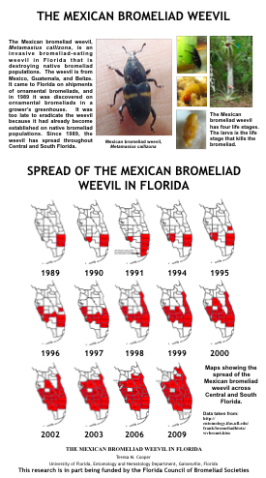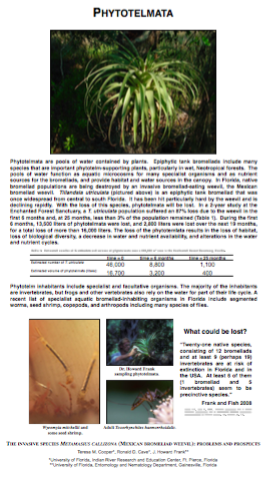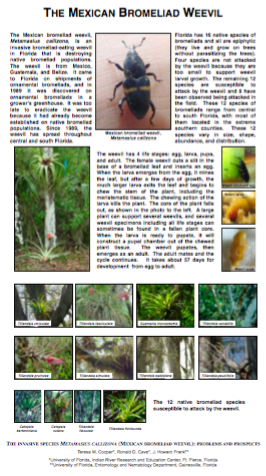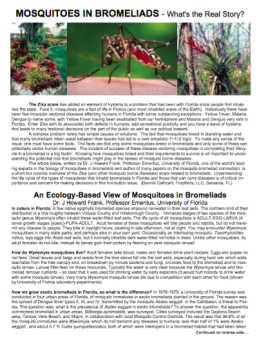Educational Materials
Educational materials may be downloaded free of charge and used for educational purposes only.
Please give credit to the authors and do not change anything in the documents.
The Giant Airplant

This is a small, illustrated book in PDF format that tells the journey of a giant airplant (Tillandsia utriculata) going from seed to seed. The book explains some of the unique qualites of this plant, such as its epiphytic lifestyle, how it receives nutrients through it's leaves and not its roots, and the aquatic ecosystems held in the axils of the plant's leaves. It brings attention to the invasive weevil that is destroying giant airplant populations throughout Florida. Some of the illustrations are line drawings that can be colored.
5" x 6.7", 23 pages.
The Mexican Bromeliad Weevil: Spread of the Mexican Bromeliad Weevil in Florida

This poster documents the spread of the Mexican bromeliad weevil in Florida from 1989 to 2009.
30" x 36"; PDF file.
Citation: Cooper TM. 2015. The Mexican bromeliad weevil: Spread of the Mexican bromeliad weevil in Florida. University of Florida.
Phytotelmata

This poster discusses the aquatic ecosystems, called phytotelmata, that develop in the axils of the leaves of the giant airplant and the loss of phytotelmata in Florida's forest canopies because the weevil is destroying giant airplant populations. The loss of phytotelmata results in the loss of habitat, loss of biological diversity, a decrease in water and nutrient availability, and alterations to water and nutrient cycles.
30" x 36"; PDF file.
Citation: Cooper TM, Cave RD, Frank JH. 2015. Phytotelmata. University of Florida.
Birds and Bromeliads

This poster discusses the relationship between birds and bromeliads. Birds use bromeliads as a water source in the canopy; as hunting grounds; for nesting material, nesting sites, or nest cover; and for fruits and flowers. These bromeliads often grow in huge, dense populations, creating an entirely new layer of habitat in the forest canopies. With the loss of Florida’s bromeliads, especially the giant airplant, bird habitat is lost.
30" x 36"; PDF file.
Citation: Cooper TM. 2015. Birds and Bromeliads. University of Florida.
The Mexican Bromeliad Weevil

This poster gives a brief history of the weevil's arrival and spread in Florida, the native bromeliads in Florida that are threatened by the weevil, and the growth of the weevil from egg to adult.
30" x 36"; PDF file.
Citation: Cooper TM, Cave RD, Frank JH. 2014. The Mexican bromeliad weevil. University of Florida.
Mosquitoes in Bromeliads - What's the Real Story?

This flyer was written in response to people's fear that bromeliads harbor mosquitoes that vector the Zika virus. The mosquitoes that vector the Zika virus, and other diseases, are not native to Florida and do not inhabit Florida's native bromeliads. Rather, native mosquitoes, that DO NOT VECTOR ANY DISEASES, inhabit Florida's native bromeliads. These native mosquitoes also predominantly inhabit exotic bromeliads used in landscaping, outcompeting the disease-vectoring mosquitoes. Please read this flyer if you are concerned with bromeliads, mosquitoes, and the Zika virus, to learn the real story.
8.5" x 11", both sides printed; PDF file.
Citation: Frank JH, Cathcart D. 2016. Mosquitoes in bromeliads - What's the real story? University of Florida and Tropiflora.
|